Vietnamese Vegan Pho Noodle Soup (Pho Chay)
Vietnamese Vegan Pho Noodle Soup (Pho Chay) can be hearty with deep savory flavors. While this vegan pho is quicker to make than traditional beef pho, it is just as comforting and delicious.
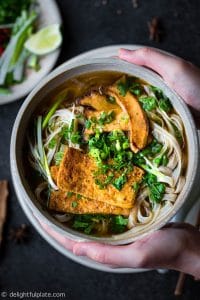
A few weeks ago, I shared a photo of my bowl of Vietnamese beef pho on Instagram. Then I was asked if I had a recipe for vegan pho (phở chay). Up until that point, I had neither cooked or eaten vegan pho. Being exposed to quite a lot of amazing vegan/vegetarian dishes recently, I felt determined to create a vegan version of pho noodle soup.
To my surprise, it wasn’t super challenging, and the result was absolutely satisfying and tasty. I really enjoy all aspects of it, from the vegetable-based broth to the vegan toppings. So, let’s touch on the main elements of this vegan pho before jumping to the recipe.
Vegetable-based Broth for Vegan Pho Noodle Soup
What is the most important element of Vietnamese pho noodle soup? Of course, it’s the broth. The answer is the same for vegan pho noodle soup. And how does regular beef pho broth taste? It’s aromatic, flavorful, hearty, savory with sweetness from simmering bones for hours.
Since vegetables are naturally sweet, it’s quite easy to replicate the sweetness. The challenge here is how to make a hearty, flavorful and savory vegan pho broth while vegetable broth is usually on the light side.
Through my experiments, I find that using mushrooms creates the hearty, meaty taste for the broth extremely well. I use fresh white mushrooms, and I recommend you do the same. I initially used dried shiitake mushrooms and then found out it wasn’t a good idea. The reason is dried shiitake mushrooms will make the broth way too dark, almost like soy sauce. As we all know, pho broth is never that dark.
To make the broth flavorful, savory with umami just like how fish sauce works in regular pho noodle soup, I also use kombu, soy sauce, and fermented black beans.
- Kombu
is edible kelp that is used intensively in Japanese cooking to make dashi stock. It is rich in glutamic acid which is responsible for umami.
- Fermented black bean (douchi) is a popular ingredient in Chinese cuisine. If you love mapo tofu (like me 🙂 ), you probably know about fermented black beans already. They are slightly pungent, very salty and full of umami.
You can find kombu and fermented black beans at Asian grocery stores. They are both essential ingredients to give this vegan pho broth deep savory flavors and umami. Using soy sauce alone isn’t quite as good, so I think it’s worth a trip to Asian grocery stores to buy them.

Pho Spices and Aromatics
We also use all the well-known pho spices here, which are cinnamon/cassia bark, star anises, cloves, fennel seeds, coriander seeds and black cardamom pods. Some of them can be bought at regular grocery stores, and you can also buy all of them at Asian grocery stores or on Amazon.
The most two important spices are cinnamon sticks/cassia bark and star anises. It’s okay if you don’t have the rest on hand. And of course, we can’t forget the charred onion and ginger when making any pho noodle soups.
Vegan Toppings for Vietnamese Vegan Pho Noodle Soup
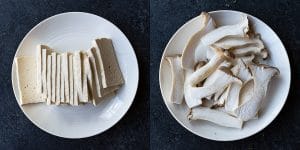
The toppings for this vegan pho are king trumpet/king oyster mushrooms and extra-firm tofu. They are thinly sliced, fried or pan-seared and then infused with pho flavors. They turn out very tasty and even though I’m not vegan, I don’t feel like missing the meat at all.
Pho Noodles and Garnishes
I like to use large pho noodles, and you can go to my pantry page for Vietnamese pho noodles to read more about it and my favorite brand. I always serve pho with a lot of sliced scallions, some cilantro and onion slices. You can also add beansprouts, birds-eye chili, lime juice, or other vegetables and mushrooms you like.
So far it sounds like a lot of work to make this vegan pho, but it really isn’t. The broth requires only 30-40 minutes of simmering, and during that time you can prepare the toppings, noodles and garnishes.
Making beef pho (both the traditional beef pho soup and the beef stew pho soup), on the contrary, takes hours. More importantly, nothing is compromised in this vegan pho noodle soup. I honestly don’t miss the bone broth, the beef slices or fish sauce at all when eating this. So even if you are not vegan, I hope you will give this a try. It is definitely among my most favorite pho noodle soups :).
I’d love to hear what you think about the dish, so please feel free to leave a comment. New recipes are added every week so let’s connect on Facebook, Pinterest and Instagram for the latest updates. You can find my collection of Vietnamese recipes here.
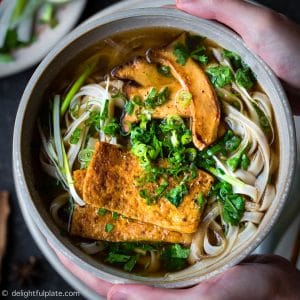
Vegan Pho Noodle Soup (Pho Chay)
Ingredients
Pho Spices & Aromatics
- 2 medium onions, quartered
- 2 large thumb-sized pieces of ginger, halved lengthwise
- 1 stick of cassia bark (or cinnamon stick)
- 6 star anises
- 3 cloves
- 1/2 tablespoon coriander seeds
- 1/2 tablespoon fennel seeds
- 1 black cardamom pods, slightly crushed
Broth
- 2 3”x4” pieces of kombu
- 7 cups water
- 3 large carrots, peeled and cut into chunks
- 1 leek, cut into chunks
- 2 celery stalks, cut into chunks
- 1 fuji apple, quartered
- 8 oz white mushrooms, halved
- 1 1/2 tablespoons fermented black beans, rinsed and drained (douchi or salted black beans)
- 1 teaspoon salt
- 1 tablespoon reduced-sodium soy sauce
- 1 tablespoon olive oil
Toppings
- 1 lb extra-firm tofu
- 8 oz king trumpet/king oyster mushrooms
- 1 tablespoon reduced sodium soy sauce, divided
Garnishes
- thinly sliced scallions
- Cilantro, roughly chopped
- bean sprouts (optional)
- other herbs and condiments of your choice
Instructions
Spices and Aromatics
- Char (or broil) onions and ginger until fragrant (about 7-10 minutes when broil on high). Remove the charred, black skin from the onions and set aside.
- Optional step: Toast all the spices in a pan with medium low to medium heat for a few minutes until aromatics. Put them in a spice bag (so that it will be easier to remove them later).
Broth
- Use damp paper towel to gently wipe the kombu. Add water and kombu in a stock pot. Turn on the stove and when the water starts simmering, discard the kombu.
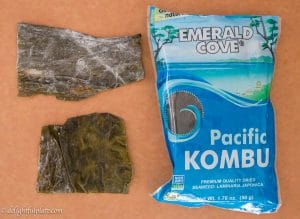
- Add carrots, leek, celery, apple, mushrooms, charred onion, ginger and the spice bag to the stockpot. Put the fermented black beans into a spice bag and add it to the stockpot. Also add salt and olive oil, bring everything to a boil, and then lower the heat to a simmer. Cover and simmer for 30-35 minutes.
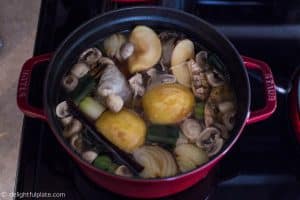
- After 30-35 minutes, remove all veggies and spices from the broth. Add soy sauce, taste the broth and adjust to your liking.
Toppings
- While the broth is simmered, prepare the toppings. Wrap the tofu block in paper towel and place a heavy object on top of it to squeeze out excess water for a few minutes. Then cut into thin slices. Also cut the king trumpet/king oyster mushrooms into thin slices.
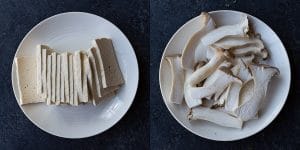
- Pan fry the tofu slices until both sides are golden. Transfer to a plate lined with paper towel to absorb excess oil. Set aside.
- After the broth is ready, place a pan over medium high heat and pan sear the mushrooms on both sides until they develop nice color and are cooked through. Reduce heat to medium, add 1/4 cup of broth and a teaspoon of soy sauce to the pan. Quickly stir fry the mushrooms until all liquid is absorbed. Transfer to a clean plate.
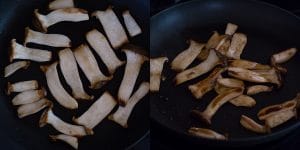
- In the same pan over medium heat, add tofu slices, about 1/4-1/3 cup of broth, the remaining soy sauce. Cook until all liquid is absorbed, flip once. You may need to cook in 2 batches depending on the amount of tofu and the size of the pan.
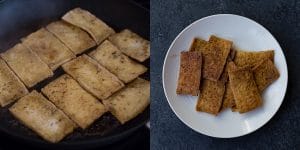
Assembling the pho bowl
- Cook pho noodles according to package instructions and prepare all the garnishes.
- Add pho noodles to serving bowls, top with tofu slices and king trumpet/oyster mushroom slices, plenty of scallions and cilantro. Bring the broth back to a boil and ladle into the bowl. Serve immediately with other garnishes of your choice.
Notes
- Kombu is edible kelp that is used intensively in Japanese cooking to make dashi stock. It is rich in glutamic acid which is responsible for umami.
- Fermented black bean (douchi) is a popular ingredient in Chinese cuisine. If you love mapo tofu (like me 🙂 ), you probably know about fermented black beans already. They are slightly pungent, very salty and full of umami.


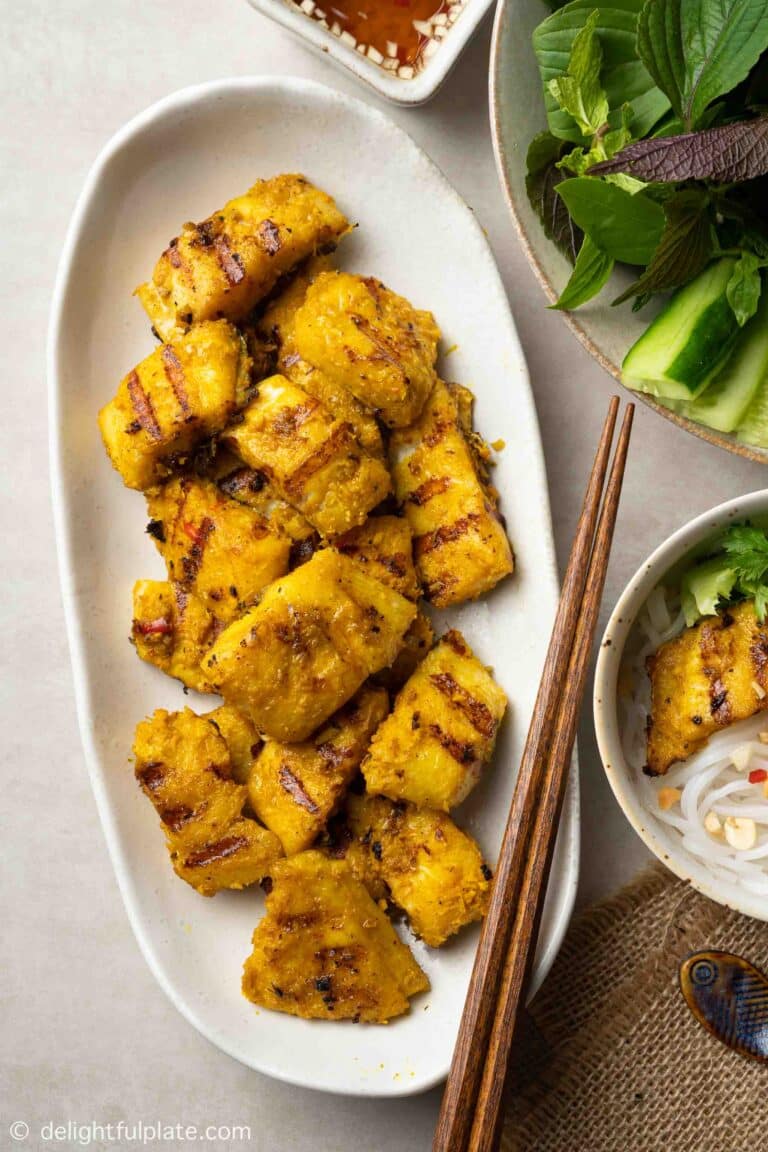
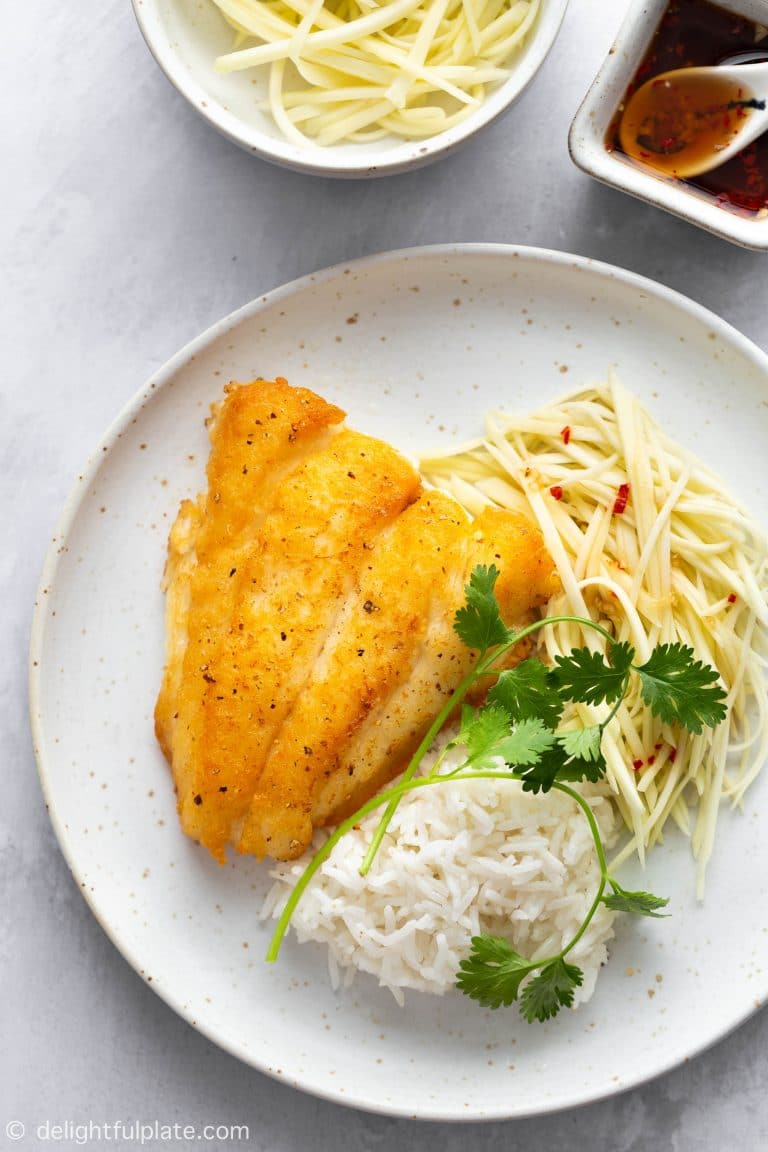
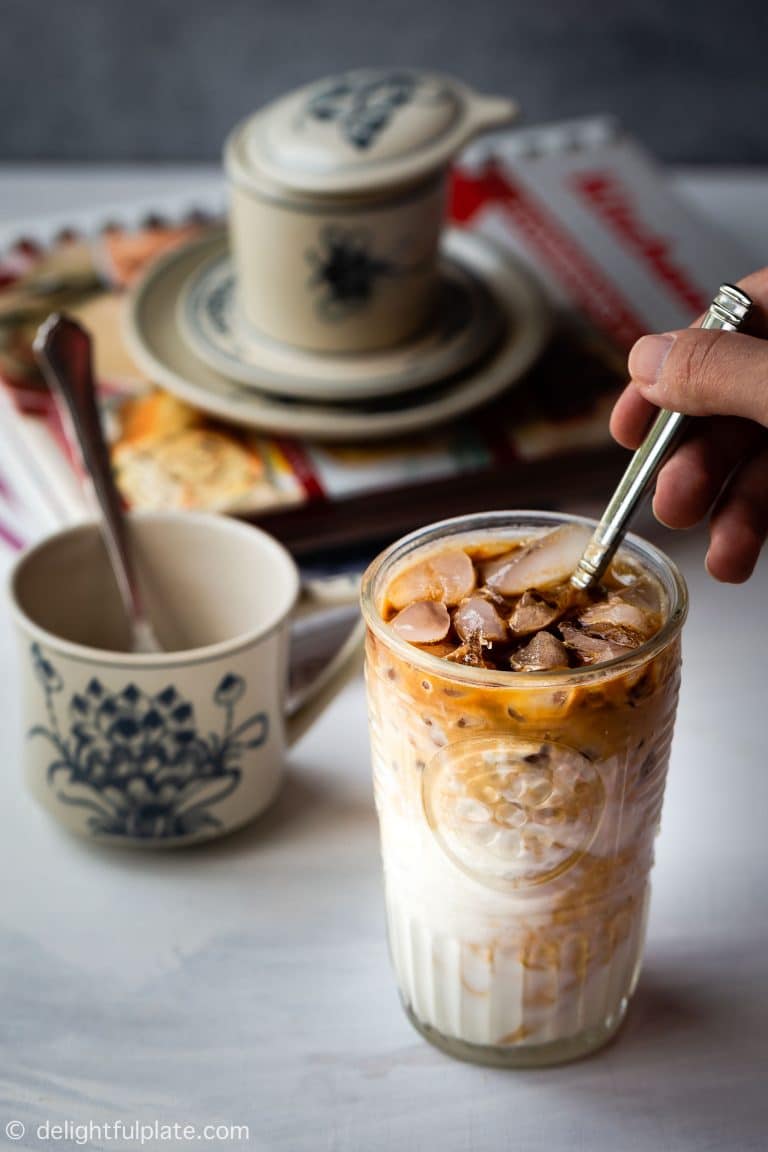

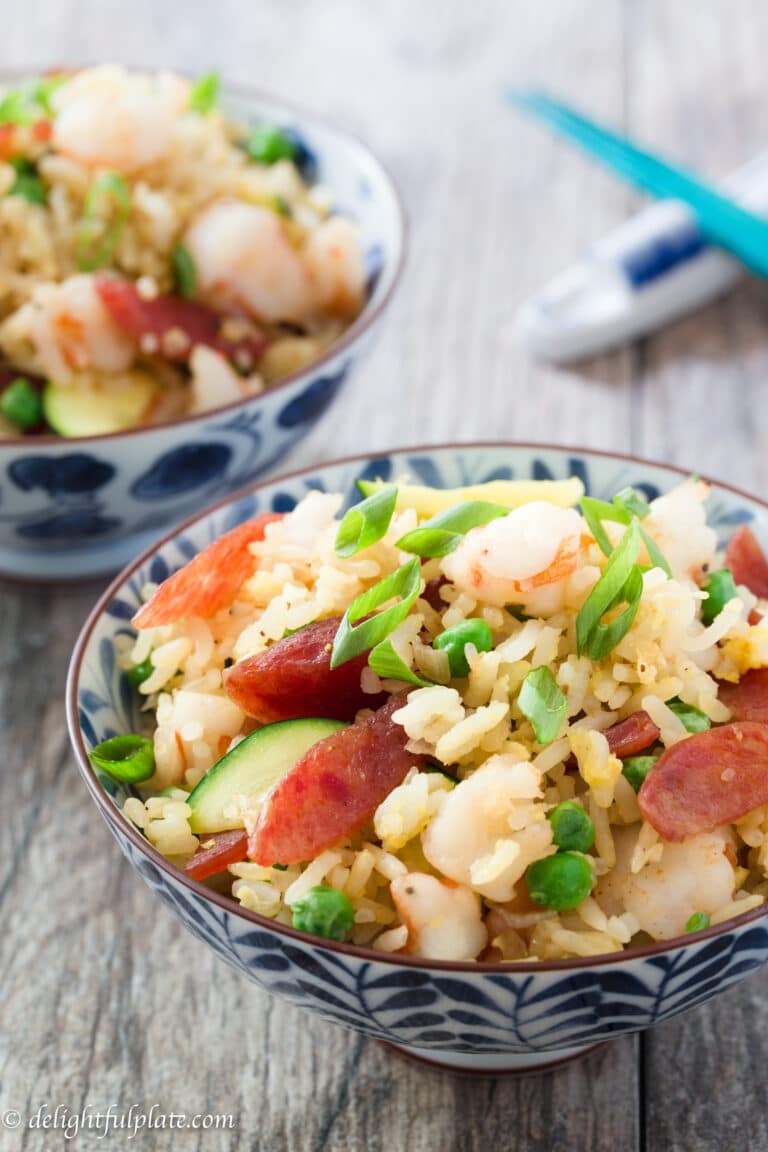
Made this earlier tonight. Delicious! Thank you for the recipe!
I just want to say ‘Thank you so much!!’ <3. I LOVE Pho Chay, but all of my attempts to make it at home were huge failures, until now! They were always so dark in color, and so bland in flavor…Your addition of kombu, fermented black beans, and white Mushrooms (instead of dried shiitake mushrooms) is what makes this recipe so, so much better than the rest out there. For the first time, I can make savory, restaurant-quality Pho Chay at home, without processed broth powder or MSG. Even my boyfriend (the meat eater) loved it! I did a few tweaks… instead of salt, olive oil and soy sauce in the broth, I used avocado oil and Yondu. Also, instead of mushrooms for topping, I used carrots, broccoli, cabbage, onion, and cilantro. I also used a pressure cooker for 15 minutes instead of 30 minutes on the stovetop. GREAT RECIPE!
Hi Isis,
Thank you so much for the feedback! I’m so glad to hear about your positive experience with the recipe :). Kombu, fermented black beans and white mushrooms together make a really flavorful base for the broth. It’s great to know the recipe also works great with a pressure cooker. I need to use mine more often haha :). Thanks again for taking the time to return and leaving me the comment!
What about lime juice ?
Hi Ivan,
You can squeeze some lime juice directly to your bowl when eating the soup.
What would be the impact if you leave the Kombu in for a long time? Recently, I made a vegan japanese miso ramen and I put fermented beancurd in for a robust flavor. Do you think that would dominate too much? It tasted fantastic with the miso ramen
Hi Tina,
If we leave the kombu in the stock for a long time, it can alter the texture, making it a little slimy. We have used fermented beancurd to make vegan versions of several Vietnamese vermicelli noodle soups. However, I don’t recommend using it to make vegan pho. It may not blend well with the flavors of pho broth. I hope this helps.
I’ll try mushrooms in my broth sometime! Can you taste the fermented black bean at all, or it mainly just adds umami? I’ve made a good vegan pho broth recently because I was never satisfied with the restaurant versions.. they always lacked that extra umami of the beefy stock that I grew up eating. So recently, what I did was lightly sauté some onions and also the veggies since that would bring out more richness and umami. Drain as much of the oil as possible and add to the pot and make your stock with that. Then add the rest (charred ginger and onion and spices). I had also added a single dried shiitake mushroom for umami but only one so it wouldn’t impart the colour and flavour. I actually made all this in a slowcooker overnight and it really allowed the flavours to blend. I’ll try a combo of my method and yours next time!
Hi Helen,
Thank you for sharing how you make vegan pho at home! The mushrooms will definitely make the broth richer and heartier. If you try adding them, I’d love to hear what you think. Kombu also adds a lot of umami and depth.
The fermented black beans are just for umami, so you won’t taste it at all. I put them in a spice pouch so that it will be easy to remove them. If unsure, you can try using a small amount the first time to see how that goes :).
I haven’t tried making vegan pho broth in a slow cooker. Did you have it on low overnight? I will put it on my list to try next time. Thank so much!
Thanks for these tips! I will try them! I find a little oil in the borth is a good thing, since beef broth does have some oil from the meat. It makes it more “meaty” – I find the problem with most vegan pho I have tried was too light feeling. I know pho broth is pretty light, but all the vegan stocks I have had (with the exception of one in Hanoi) was too much like vegetable stock.
Yes, just on low in the slow cooker overnight! I think it allows the flavours to really meld together because it is all merging for so long. It also mes cooking it a breeze! And it is perfect for a quick bowl of hot pho for breakfast. 🙂
I agree that we need some amount of oil in the broth (that’s why I still added oil to the broth although I was lazy and skipped sautéing the veggies ^^). When I still cooked beef pho at home, I noticed that the broth would be weaker and less fragrant when I skimmed off too much fat. I think it’s because some chemical compounds that make our food flavorful are only soluble in fats. Besides, fats also give us a rich mouthfeel.
Do you still remember the place where you had good vegan pho in Hanoi? I’d love to check it out when I return for the Lunar New Year in January. And last question about using the slow cooker if you don’t mind :). I assume the veggies will be quite soft in the morning. Is it easy to remove them and do you chop them fairly large?
Yeah, you can even try pouring the broth out into another pot (through a strainer perhaps) and discarding the veggies. They do get soft and soggy. I just leave them at the bottom and scoop up the soup around it.
It was a nice restaurant buffet near the train station.. you buy a ticket first before you can eat. Unfortunately, I can’t recall the name. There are so many veg restaurants in Hanoi now! There is a good one on Doi Can, and also a great one on Ngoc Ha (it was closed for awhile.. hope it’s back!). Also, I used to visit one in an alley off of Kim Ma. There is that longtime one also in the French Quarter, where you enter through the back. Sorry I can’t recall the names to any of these!
Here is a good source: https://www.happycow.net/asia/vietnam/hanoi/?filters=chains
Oh I found some of them:
https://www.happycow.net/reviews/an-lac-vegetarian-hanoi-72337
http://comchayhathanh.com/ (one of my faves)
https://www.foody.vn/ha-noi/sala-quan-com-chay (one of my other faves – if they’re open)
https://www.happycow.net/reviews/com-chay-nang-tam-hanoi-3353 (my meat eating family and fam friends also liked this place when we went)
https://www.foody.vn/ha-noi/vo-uu-quan-am-thuc-chay
This looks delicious, so comforting, warm and inviting. Gonna have to try this, thank you for sharing, Sophie! 🙂
Hi Nicole! Thank you for the comment! If you try it, please feel free to let me know how it goes. I’m so glad to see you here because I like your photos so much. They are gorgeous and often make me feel emotional :).